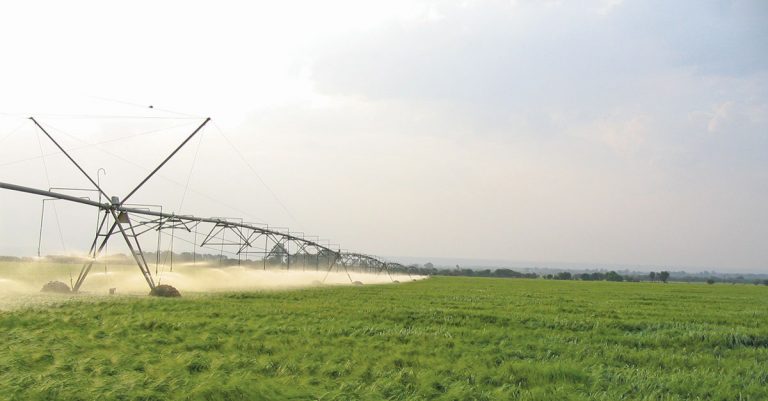
Integrated pest management: Taking care of crop protectors
In a well-functioning ecosystem, that which affects one organism in a system will affect all other organisms. Continuous monocropping, in contrast, eventually leads to the removal of the components of a healthy ecosystem, according to Dr Astrid Jankielsohn, senior researcher in entomology at the Agricultural Research Council’s (ARC) Small Grains Institute in Bethlehem.
She says that this is particularly evident in the light of climate change. Many insect species are able to survive adverse conditions and are highly adaptable to change. This enables them to increase their populations when conditions become suitable.
When there is no balance, however, such as in a monocropping system, insect pests can become a serious problem. This could be because beneficial predator insects that keep pest populations under the damage threshold are missing from the agricultural system.
Insect populations in intercropped systems are more diverse because of increased crop diversity. Insects included in this system perform diverse ecosystem functions, such as controlling pest insects, pollination, bioturbation (restructuring sedimentary deposits), and fertilisation of the soil.
“These services provided by insects can be utilised in agricultural systems by changing and diversifying the agricultural environment through intercropping. This provides an advantage over, for instance, a conventional wheat production system, because the diversity in an intercropped wheat ecosystem will enable it to adjust to adverse conditions and become more resilient and sustainable,” Jankielsohn explains.
Sustainability versus profitability
In Jankielsohn’s opinion, sustainability equals profitability. Integrated pest management (IPM) refers to a systems-based approach that is aimed at minimising the use of chemicals whilst maximising plant health and environmental biodiversity. When using an IPM system, a farmer’s economic sustainability will increase because the need for expensive inputs such as pesticides will decline.
Increased environmental sustainability, which often includes the use of cover crops and intercropping, also means continuous ground cover. This will reduce the occurrence of wind and water erosion as well as increase the ability of the cropping system to use resources
such as sunlight, water and soil nutrients more effectively.
This type of system includes insect-friendly plants, border crops, cover crops, and water reservoirs such as perennial plants, into which an annual row crop can be planted.
Implementation of intercropping
Jankielsohn says it is a good idea to start with a simple intercropping plan, such as including strips of cover crops within the cash crop field to attract beneficial insects.
“Later on, other elements could be added, such as perennial border crops of herbs and flowers that repel pest insects and provide beneficial habitats to support their natural enemies.”
In this way, the cropping system can gradually become more diverse. The choice of border plants depends on the cash crop, geographical location, and the insects that occur in the area. Good plants to choose are hardy, drought-tolerant perennials that will attract beneficial insects and repel pests.
They should also have deep root systems that can accumulate potassium, phosphorus, and copper from the subsoil, and they must be useful as living mulch and cover crops in dry areas.
The cover crop (intercrop) should be adapted and grow well in the area. Ideal plants will provide food and shelter for all life stages of beneficial organisms, suppress weeds, and grow in close proximity to the cash crop without competing for space, light, water and nutrients.
Jankielsohn advises that the cover crop and cash crop occupy different above- and below-
ground niches and complement each other, thereby increasing the cropping system’s
ability to capture and use resources efficiently.
Legumes, clovers, and many herb species such as yarrow, fennel, tansy, catnip and African wormwood fit these criteria.
“In planning an intercropped system, it is important to identify specific plants and management practices that best support populations of beneficial organisms. This requires some information gathering and management skill on the part of the producer, but has many benefits,” she says.
Valuable parasitoids and predators
According to entomologist Dr Goddy Prinsloo, a researcher in insect pest control, pest management, and IPM at the ARC, it is vital for sustainable crop production that farmers realise that unsprayed or untreated fields are full of beneficial insects such as parasitoids and predators that keep the numbers of damage-causing pest under control.
These natural enemies may be more susceptible to pesticides than the targeted pests, which could result in pesticide applications killing them off and leaving the pests to develop unchecked.
Prinsloo says that for long-term sustainability and profitability, non-chemical crop protection methods are vital.
“Over-reliance on chemical control is associated with contamination of ecosystems and undesirable effects on health. The future of crop production is also threatened by the emergence of pests’ resistance [to chemicals] and the declining availability of active substances.”
Crop pests include higher animals such as rats, mice and birds, but they are more often lower animals such as insects, mites, nematodes (microscopically small worms) or snails. Weeds are also classified as pests, while micro-organisms such as fungi, bacteria and viruses can also cause harmful plant diseases.
Not all organisms are a nuisance
The mere presence of these organisms on a farm, however, does not make them pests, Prinsloo explains. In principle, they are not considered pests until they cause damage
to crops. For example, plants can be damaging or useful, depending on the circumstances.
In crop production, weeds are a problem, whereas the same weeds are often a valuable source of animal feed. Nevertheless, seeds, bulbs or roots left on a field after a crop is harvested can cause serious weed infestation in the next production season.
Insect pests eat parts of or the entire plant, or pierce them and feed on their sap. Micro-organisms, which include nematodes, can also be pests, as they cause plant diseases. The symptoms of such diseases can include malformation, spots on the plants’ leaves, and rotting stems, fruit or roots.
Most weeds are harmful because they compete with the crop plants for light, water and nutrients, slowing down the crop’s growth.
According to Prof Driekie Fourie of the Unit for Environmental Sciences and Management’s Integrated Pest Management division at North-West University, a single female root-knot nematode (Meloidogyne spp) can produce up to 1 800 eggs within 20 to 30 days after infecting the root of a host plant at a soil temperature of 26°C.
This was reported in a susceptible soya bean cultivar.
Grains planted in soil that is infested with nematode pests are bound to be negatively affected. Root-knot and lesion (Pratylenchus spp) nematodes are the most important ones that grain producers face.
“They can survive in roots of volunteer plants, such as ragwort (Senecio consanguineus). Nematodes are hardy, and live female root-knot nematodes have been found in the middle of winter in the Free State on ragwort bushes,” Fourie explains.
Health and well-being for all
The quality of food and how it is produced are becoming more important to consumers. In homes across the globe, a spotlight has been placed on health and wellness since the onset of the COVID-19 pandemic.
According to the Food and Agricultural Organization of the United Nations, food production needs to increase by 70% in order to feed the world’s burgeoning population.
“This growing need is also set against the backdrop of climate change, shrinking [area of] arable land, and limited natural resources. These challenges demand an accelerated change in sustainable farming practices to maximise yields, achieve resource efficiency, and preserve natural resources,” says Donvae Hooker, business communications lead for Madumbi Sustainable Agriculture, which provides IPM solutions.
A move towards ‘green’ farming
These days, consumers are more environmentally conscious than ever, and farmers are challenged to achieve their sustainability objectives and increase profitability, but keep prices affordable for consumers, Hooker says.
“The responsible use of chemicals and an understanding of how agriculture impacts our environment are constantly in the public eye. Consumers are driving the change towards natural elements and processes in food production.”
For this reason, there is a growing demand for biological solutions. According to Hooker, agricultural biologicals are a varied group of products that are derived from naturally occurring micro-organisms, plant extracts, beneficial insects, or other organic matter. They are typically broken down into categories, according to their use in agriculture.
“Biologicals support growers in building bioactive soils, maximising soil and plant health, and providing proven pest management solutions with minimal impact on the environment and everyone in it.”
The farmer’s challenge, she says, is to learn to work with nature, rather than against it, to create robust, healthy plants that are less susceptible to disease. The significant strides that have been taken towards the commercialisation of bio-insecticides and bio-fungicides have resulted in solutions that are highly effective and increasingly user-friendly.
Email Dr Astrid Jankielsohn at JankielsohnA@arc.agric.za, Dr Goddy Prinsloo at
PrinslooGJ@arc.agric.za, Prof Driekie Fourie at Driekie.Fourie@nwu.ac.za, or Donvae Hooker at marketing@madumbi.co.za.
Source: farmersweekly.co.za
